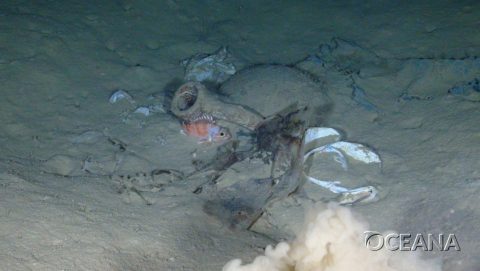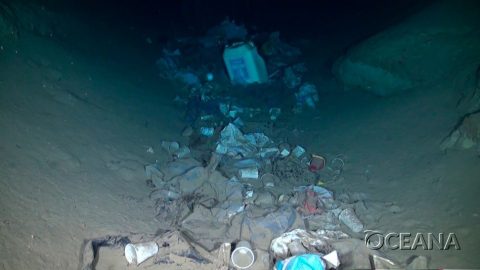Oceana uncovers the plastic plague in Europe’s deep seas
Press Release Date: July 13, 2020
Location: Madrid
Contact:
Irene Campmany | email: icampmany@oceana.org | tel.: +34 682 622 245
99% of plastic ends up in the deep sea, with no data on how many centuries it takes to decompose in these environments
Oceana has published a study with photos from the past decade illustrating the need to drastically reduce plastic use
Madrid. – Oceana has published a report on the disastrous effects of plastic on the seafloor in Europe and the Mediterranean. Photos from their expeditions — some of which were published for the first time — confirm that the litter which accumulates on beaches and the surface of the oceans accounts for only 1% of all the plastic dumped into the marine environment. The remaining 99% ends up hundreds of metres below the surface[i], threatening areas of high biological value, such as seamounts, canyons and escarpments.
The director of the Plastics campaign at Oceana in Europe, Natividad Sánchez, explains that “Through this study we intend to raise awareness of the invisible reality of the deep seafloor, which ends up hosting most of the plastics that are dumped into the ocean. Measures such as beach cleaning and surface waste collection are crucial, but insufficient if we are to tackle the root problem of plastics in the ocean. It is essential that we reduce the manufacture of single-use plastics and we need ambitious national legislation that goes beyond the recommendations set out in the European Directive 2019/904“.
The seafloor stands out for its high biodiversity and as a strategic feeding and reproduction point for emblematic species such as corals, cetaceans and sharks. Underwater geographical features and currents, however, channel plastic debris and deposit the waste in the depths — creating large underwater dumps. In addition, due to low temperatures and lack of light, the degradation of this waste is slower than in surface waters, so that the plastics remain intact for centuries.
“The seafloor is the great forgotten when it comes to ocean governance. Over just a few years, oases of life like seamounts, canyons and escarpments have been turned into landfills. Semi-enclosed seas are very worrying, particularly the Mediterranean, due to the human pressure it is under and the great depth of its waters“, says the director of Expeditions at Oceana in Europe, Ricardo Aguilar.
The vulnerability of submarine landscapes means that these ecosystems are deeply affected by the impact of plastics. In fact, the environmental cost of this damage, compared to the low price of plastic, is incalculable, since once affected, deep-sea ecosystems will need centuries to recover.
|
|
 |
| OCEANA © | OCEANA © LIFE Ba?AR for N2K |


